HI5017 Managerial Accounting: Activity Based Costing at ANZ Bank
VerifiedAdded on 2023/06/12
|14
|2918
|278
Report
AI Summary
This report provides an analysis of Activity-Based Costing (ABC) and its potential application within ANZ Bank. It begins with an introduction to management accounting and the features of ABC, highlighting its role in allocating costs and improving productivity. The report then profiles ANZ Bank, outlini...
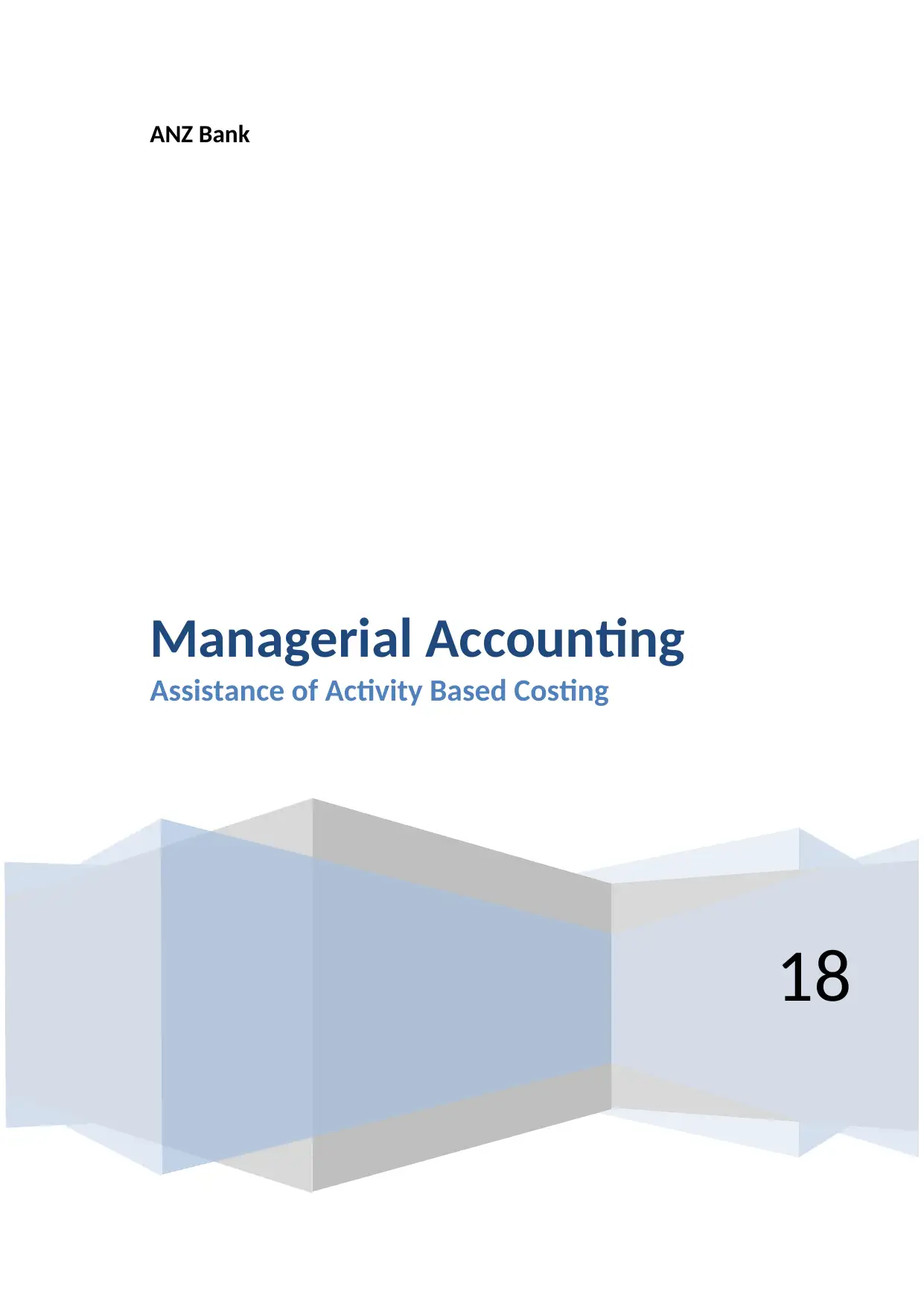
ANZ Bank
18
Managerial Accounting
Assistance of Activity Based Costing
18
Managerial Accounting
Assistance of Activity Based Costing
Paraphrase This Document
Need a fresh take? Get an instant paraphrase of this document with our AI Paraphraser
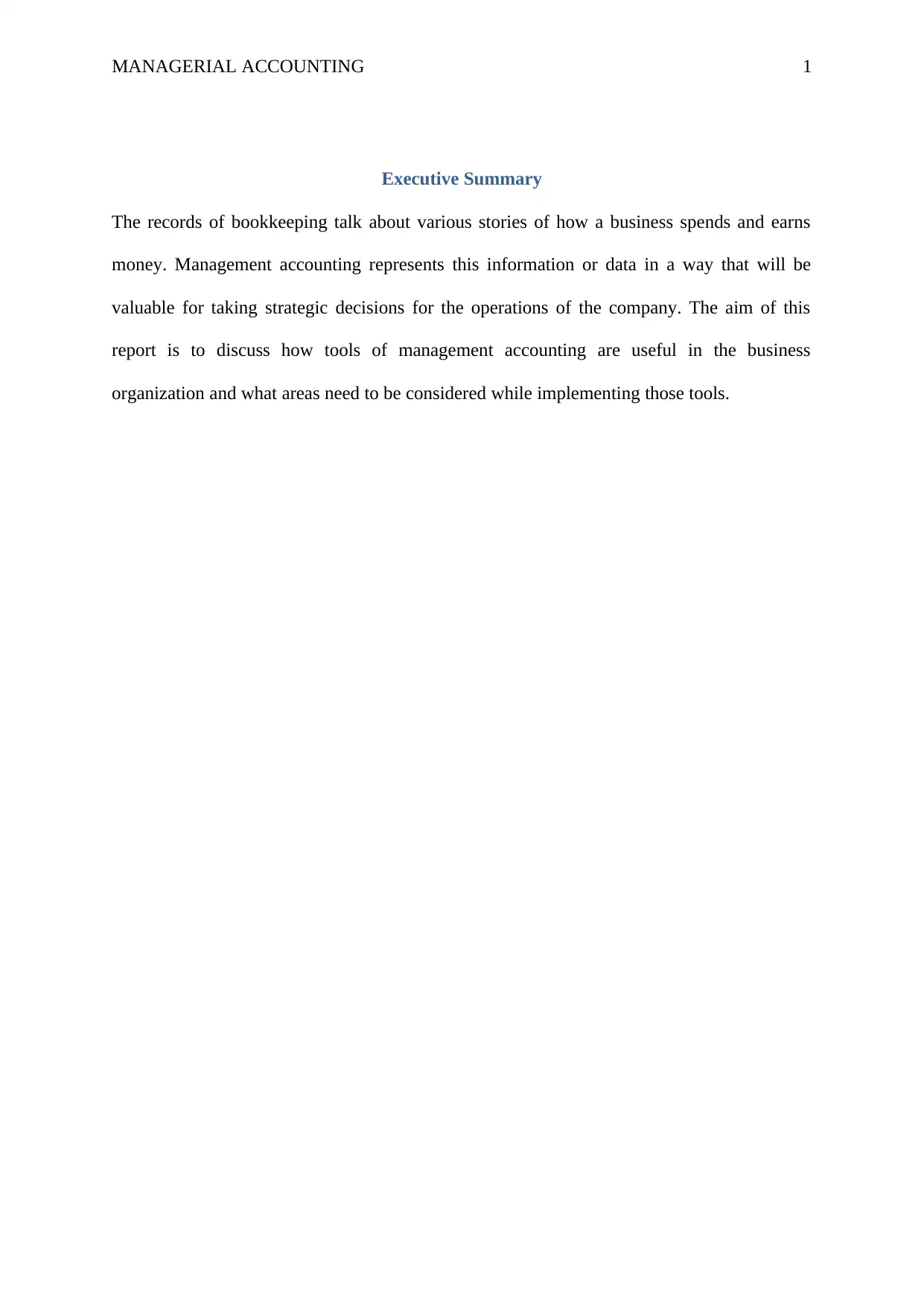
MANAGERIAL ACCOUNTING 1
Executive Summary
The records of bookkeeping talk about various stories of how a business spends and earns
money. Management accounting represents this information or data in a way that will be
valuable for taking strategic decisions for the operations of the company. The aim of this
report is to discuss how tools of management accounting are useful in the business
organization and what areas need to be considered while implementing those tools.
Executive Summary
The records of bookkeeping talk about various stories of how a business spends and earns
money. Management accounting represents this information or data in a way that will be
valuable for taking strategic decisions for the operations of the company. The aim of this
report is to discuss how tools of management accounting are useful in the business
organization and what areas need to be considered while implementing those tools.
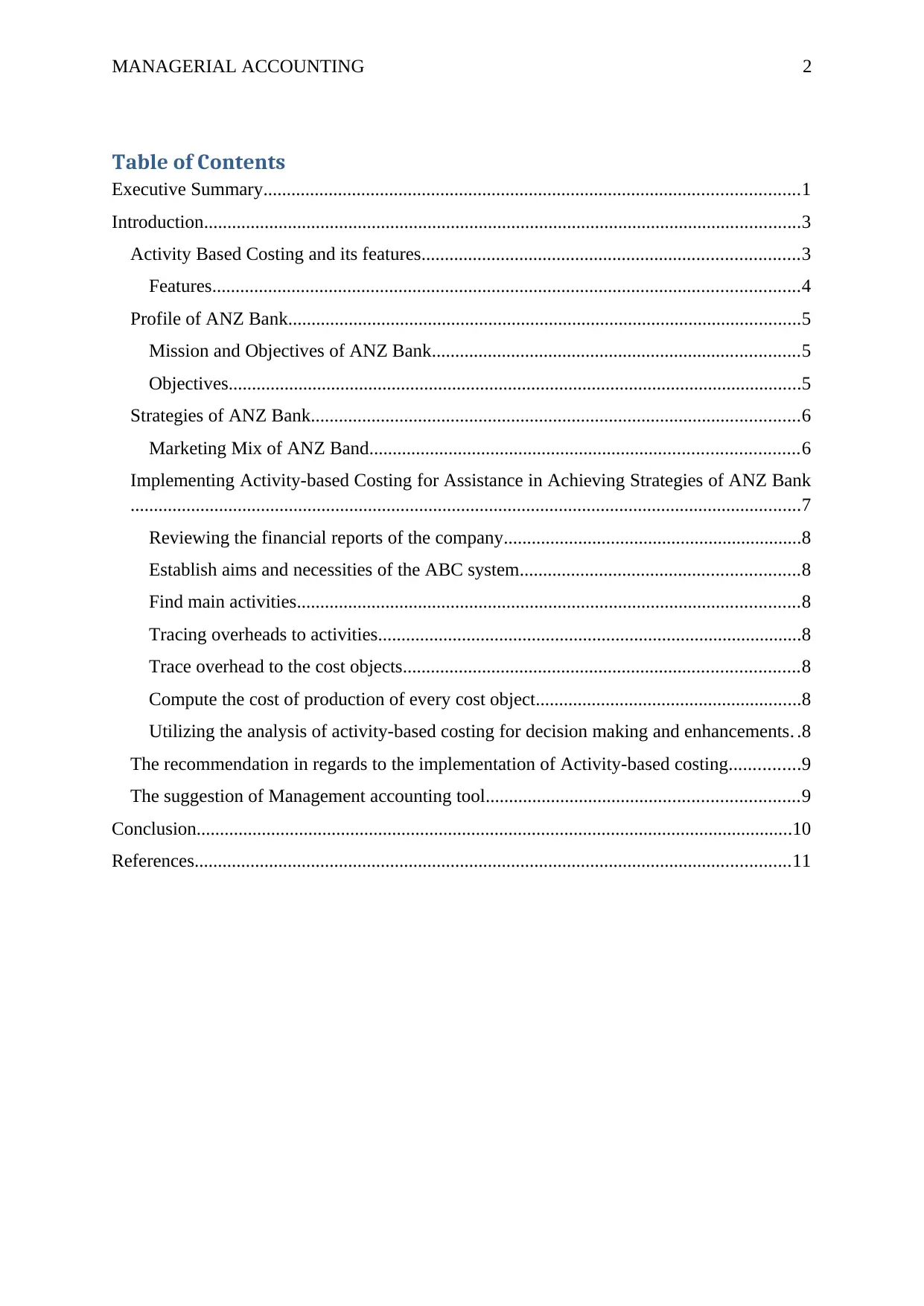
MANAGERIAL ACCOUNTING 2
Table of Contents
Executive Summary...................................................................................................................1
Introduction................................................................................................................................3
Activity Based Costing and its features.................................................................................3
Features..............................................................................................................................4
Profile of ANZ Bank..............................................................................................................5
Mission and Objectives of ANZ Bank...............................................................................5
Objectives...........................................................................................................................5
Strategies of ANZ Bank.........................................................................................................6
Marketing Mix of ANZ Band............................................................................................6
Implementing Activity-based Costing for Assistance in Achieving Strategies of ANZ Bank
................................................................................................................................................7
Reviewing the financial reports of the company................................................................8
Establish aims and necessities of the ABC system............................................................8
Find main activities............................................................................................................8
Tracing overheads to activities...........................................................................................8
Trace overhead to the cost objects.....................................................................................8
Compute the cost of production of every cost object.........................................................8
Utilizing the analysis of activity-based costing for decision making and enhancements. .8
The recommendation in regards to the implementation of Activity-based costing...............9
The suggestion of Management accounting tool...................................................................9
Conclusion................................................................................................................................10
References................................................................................................................................11
Table of Contents
Executive Summary...................................................................................................................1
Introduction................................................................................................................................3
Activity Based Costing and its features.................................................................................3
Features..............................................................................................................................4
Profile of ANZ Bank..............................................................................................................5
Mission and Objectives of ANZ Bank...............................................................................5
Objectives...........................................................................................................................5
Strategies of ANZ Bank.........................................................................................................6
Marketing Mix of ANZ Band............................................................................................6
Implementing Activity-based Costing for Assistance in Achieving Strategies of ANZ Bank
................................................................................................................................................7
Reviewing the financial reports of the company................................................................8
Establish aims and necessities of the ABC system............................................................8
Find main activities............................................................................................................8
Tracing overheads to activities...........................................................................................8
Trace overhead to the cost objects.....................................................................................8
Compute the cost of production of every cost object.........................................................8
Utilizing the analysis of activity-based costing for decision making and enhancements. .8
The recommendation in regards to the implementation of Activity-based costing...............9
The suggestion of Management accounting tool...................................................................9
Conclusion................................................................................................................................10
References................................................................................................................................11
⊘ This is a preview!⊘
Do you want full access?
Subscribe today to unlock all pages.

Trusted by 1+ million students worldwide
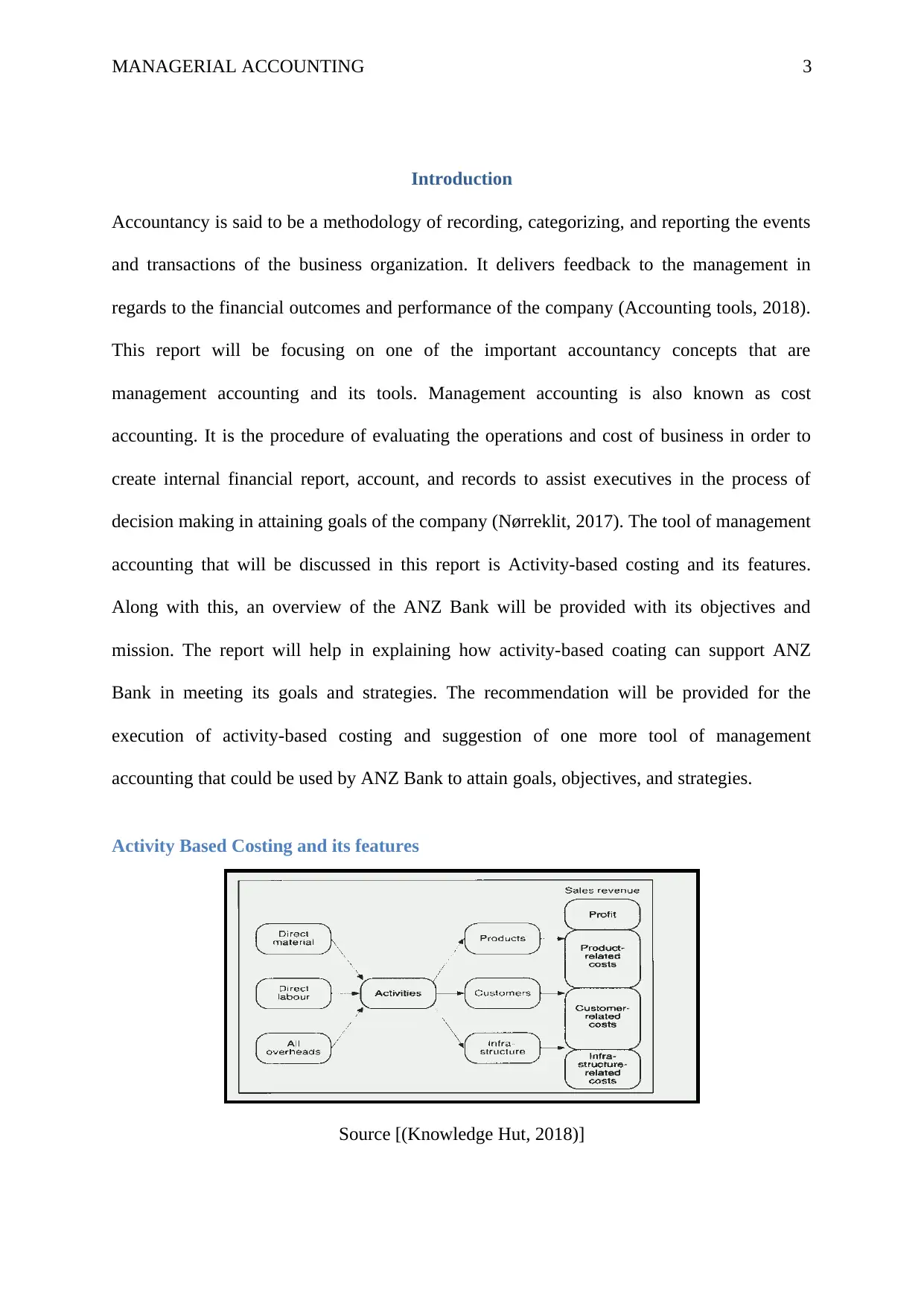
MANAGERIAL ACCOUNTING 3
Introduction
Accountancy is said to be a methodology of recording, categorizing, and reporting the events
and transactions of the business organization. It delivers feedback to the management in
regards to the financial outcomes and performance of the company (Accounting tools, 2018).
This report will be focusing on one of the important accountancy concepts that are
management accounting and its tools. Management accounting is also known as cost
accounting. It is the procedure of evaluating the operations and cost of business in order to
create internal financial report, account, and records to assist executives in the process of
decision making in attaining goals of the company (Nørreklit, 2017). The tool of management
accounting that will be discussed in this report is Activity-based costing and its features.
Along with this, an overview of the ANZ Bank will be provided with its objectives and
mission. The report will help in explaining how activity-based coating can support ANZ
Bank in meeting its goals and strategies. The recommendation will be provided for the
execution of activity-based costing and suggestion of one more tool of management
accounting that could be used by ANZ Bank to attain goals, objectives, and strategies.
Activity Based Costing and its features
Source [(Knowledge Hut, 2018)]
Introduction
Accountancy is said to be a methodology of recording, categorizing, and reporting the events
and transactions of the business organization. It delivers feedback to the management in
regards to the financial outcomes and performance of the company (Accounting tools, 2018).
This report will be focusing on one of the important accountancy concepts that are
management accounting and its tools. Management accounting is also known as cost
accounting. It is the procedure of evaluating the operations and cost of business in order to
create internal financial report, account, and records to assist executives in the process of
decision making in attaining goals of the company (Nørreklit, 2017). The tool of management
accounting that will be discussed in this report is Activity-based costing and its features.
Along with this, an overview of the ANZ Bank will be provided with its objectives and
mission. The report will help in explaining how activity-based coating can support ANZ
Bank in meeting its goals and strategies. The recommendation will be provided for the
execution of activity-based costing and suggestion of one more tool of management
accounting that could be used by ANZ Bank to attain goals, objectives, and strategies.
Activity Based Costing and its features
Source [(Knowledge Hut, 2018)]
Paraphrase This Document
Need a fresh take? Get an instant paraphrase of this document with our AI Paraphraser
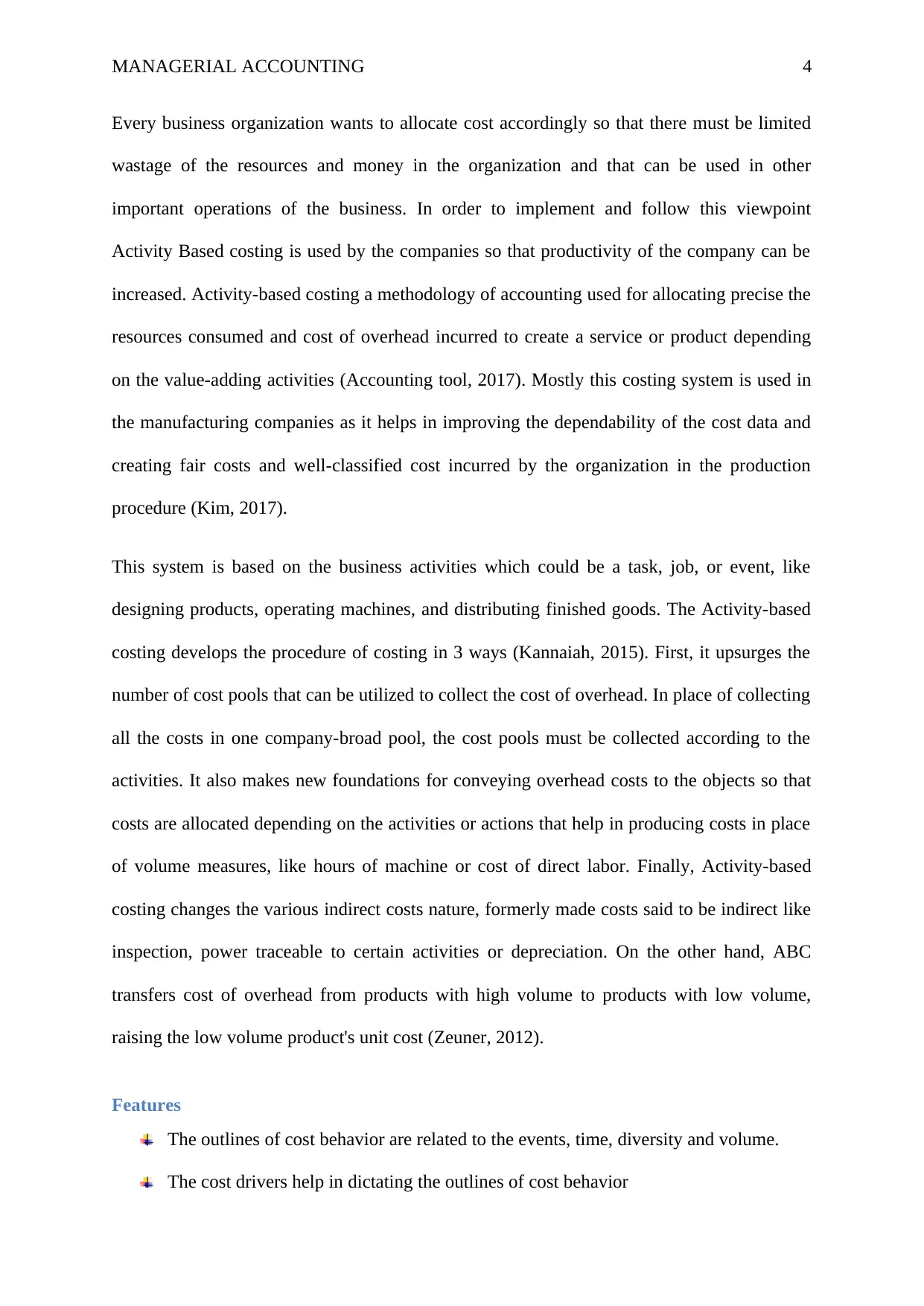
MANAGERIAL ACCOUNTING 4
Every business organization wants to allocate cost accordingly so that there must be limited
wastage of the resources and money in the organization and that can be used in other
important operations of the business. In order to implement and follow this viewpoint
Activity Based costing is used by the companies so that productivity of the company can be
increased. Activity-based costing a methodology of accounting used for allocating precise the
resources consumed and cost of overhead incurred to create a service or product depending
on the value-adding activities (Accounting tool, 2017). Mostly this costing system is used in
the manufacturing companies as it helps in improving the dependability of the cost data and
creating fair costs and well-classified cost incurred by the organization in the production
procedure (Kim, 2017).
This system is based on the business activities which could be a task, job, or event, like
designing products, operating machines, and distributing finished goods. The Activity-based
costing develops the procedure of costing in 3 ways (Kannaiah, 2015). First, it upsurges the
number of cost pools that can be utilized to collect the cost of overhead. In place of collecting
all the costs in one company-broad pool, the cost pools must be collected according to the
activities. It also makes new foundations for conveying overhead costs to the objects so that
costs are allocated depending on the activities or actions that help in producing costs in place
of volume measures, like hours of machine or cost of direct labor. Finally, Activity-based
costing changes the various indirect costs nature, formerly made costs said to be indirect like
inspection, power traceable to certain activities or depreciation. On the other hand, ABC
transfers cost of overhead from products with high volume to products with low volume,
raising the low volume product's unit cost (Zeuner, 2012).
Features
The outlines of cost behavior are related to the events, time, diversity and volume.
The cost drivers help in dictating the outlines of cost behavior
Every business organization wants to allocate cost accordingly so that there must be limited
wastage of the resources and money in the organization and that can be used in other
important operations of the business. In order to implement and follow this viewpoint
Activity Based costing is used by the companies so that productivity of the company can be
increased. Activity-based costing a methodology of accounting used for allocating precise the
resources consumed and cost of overhead incurred to create a service or product depending
on the value-adding activities (Accounting tool, 2017). Mostly this costing system is used in
the manufacturing companies as it helps in improving the dependability of the cost data and
creating fair costs and well-classified cost incurred by the organization in the production
procedure (Kim, 2017).
This system is based on the business activities which could be a task, job, or event, like
designing products, operating machines, and distributing finished goods. The Activity-based
costing develops the procedure of costing in 3 ways (Kannaiah, 2015). First, it upsurges the
number of cost pools that can be utilized to collect the cost of overhead. In place of collecting
all the costs in one company-broad pool, the cost pools must be collected according to the
activities. It also makes new foundations for conveying overhead costs to the objects so that
costs are allocated depending on the activities or actions that help in producing costs in place
of volume measures, like hours of machine or cost of direct labor. Finally, Activity-based
costing changes the various indirect costs nature, formerly made costs said to be indirect like
inspection, power traceable to certain activities or depreciation. On the other hand, ABC
transfers cost of overhead from products with high volume to products with low volume,
raising the low volume product's unit cost (Zeuner, 2012).
Features
The outlines of cost behavior are related to the events, time, diversity and volume.
The cost drivers help in dictating the outlines of cost behavior
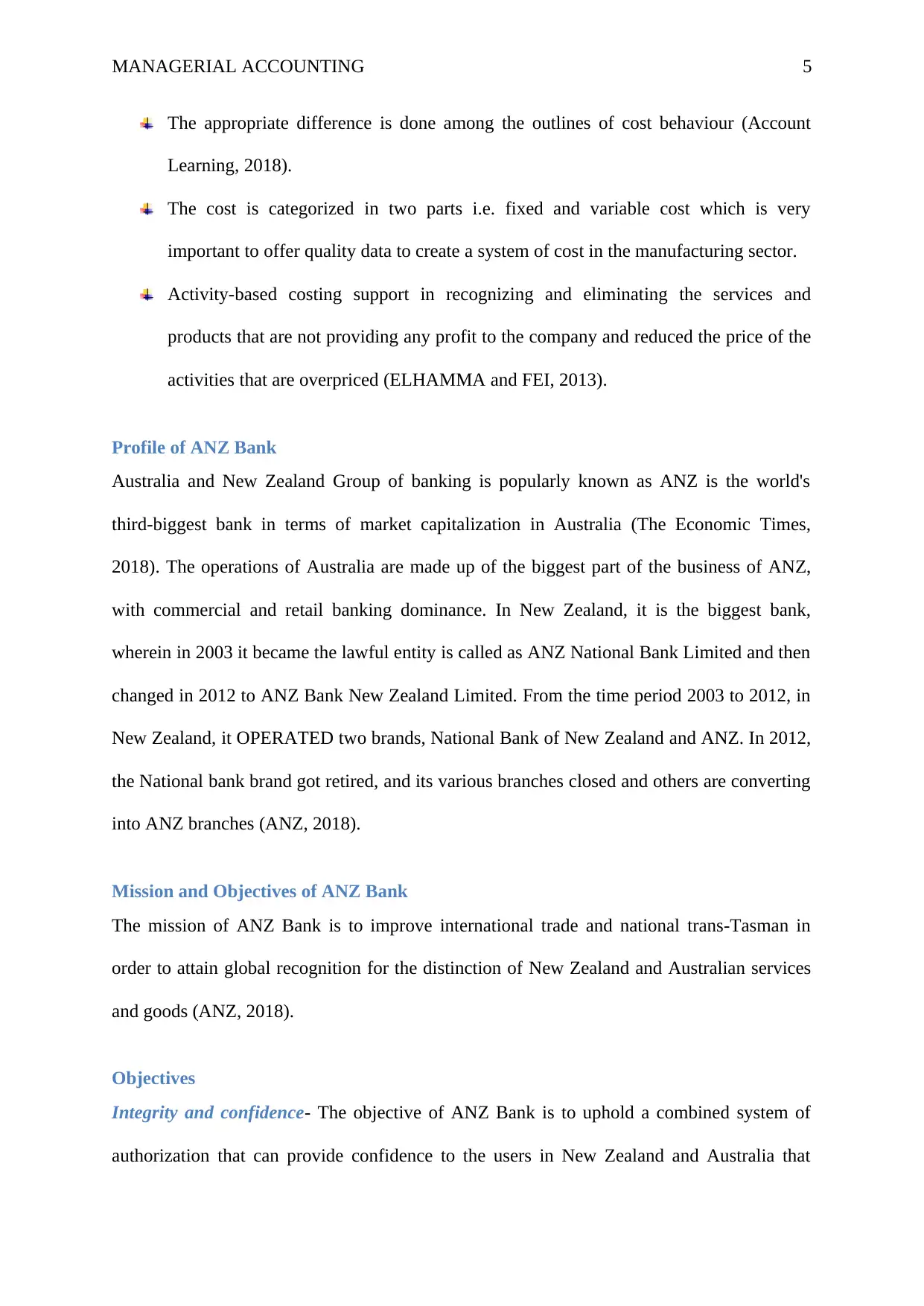
MANAGERIAL ACCOUNTING 5
The appropriate difference is done among the outlines of cost behaviour (Account
Learning, 2018).
The cost is categorized in two parts i.e. fixed and variable cost which is very
important to offer quality data to create a system of cost in the manufacturing sector.
Activity-based costing support in recognizing and eliminating the services and
products that are not providing any profit to the company and reduced the price of the
activities that are overpriced (ELHAMMA and FEI, 2013).
Profile of ANZ Bank
Australia and New Zealand Group of banking is popularly known as ANZ is the world's
third-biggest bank in terms of market capitalization in Australia (The Economic Times,
2018). The operations of Australia are made up of the biggest part of the business of ANZ,
with commercial and retail banking dominance. In New Zealand, it is the biggest bank,
wherein in 2003 it became the lawful entity is called as ANZ National Bank Limited and then
changed in 2012 to ANZ Bank New Zealand Limited. From the time period 2003 to 2012, in
New Zealand, it OPERATED two brands, National Bank of New Zealand and ANZ. In 2012,
the National bank brand got retired, and its various branches closed and others are converting
into ANZ branches (ANZ, 2018).
Mission and Objectives of ANZ Bank
The mission of ANZ Bank is to improve international trade and national trans-Tasman in
order to attain global recognition for the distinction of New Zealand and Australian services
and goods (ANZ, 2018).
Objectives
Integrity and confidence- The objective of ANZ Bank is to uphold a combined system of
authorization that can provide confidence to the users in New Zealand and Australia that
The appropriate difference is done among the outlines of cost behaviour (Account
Learning, 2018).
The cost is categorized in two parts i.e. fixed and variable cost which is very
important to offer quality data to create a system of cost in the manufacturing sector.
Activity-based costing support in recognizing and eliminating the services and
products that are not providing any profit to the company and reduced the price of the
activities that are overpriced (ELHAMMA and FEI, 2013).
Profile of ANZ Bank
Australia and New Zealand Group of banking is popularly known as ANZ is the world's
third-biggest bank in terms of market capitalization in Australia (The Economic Times,
2018). The operations of Australia are made up of the biggest part of the business of ANZ,
with commercial and retail banking dominance. In New Zealand, it is the biggest bank,
wherein in 2003 it became the lawful entity is called as ANZ National Bank Limited and then
changed in 2012 to ANZ Bank New Zealand Limited. From the time period 2003 to 2012, in
New Zealand, it OPERATED two brands, National Bank of New Zealand and ANZ. In 2012,
the National bank brand got retired, and its various branches closed and others are converting
into ANZ branches (ANZ, 2018).
Mission and Objectives of ANZ Bank
The mission of ANZ Bank is to improve international trade and national trans-Tasman in
order to attain global recognition for the distinction of New Zealand and Australian services
and goods (ANZ, 2018).
Objectives
Integrity and confidence- The objective of ANZ Bank is to uphold a combined system of
authorization that can provide confidence to the users in New Zealand and Australia that
⊘ This is a preview!⊘
Do you want full access?
Subscribe today to unlock all pages.

Trusted by 1+ million students worldwide
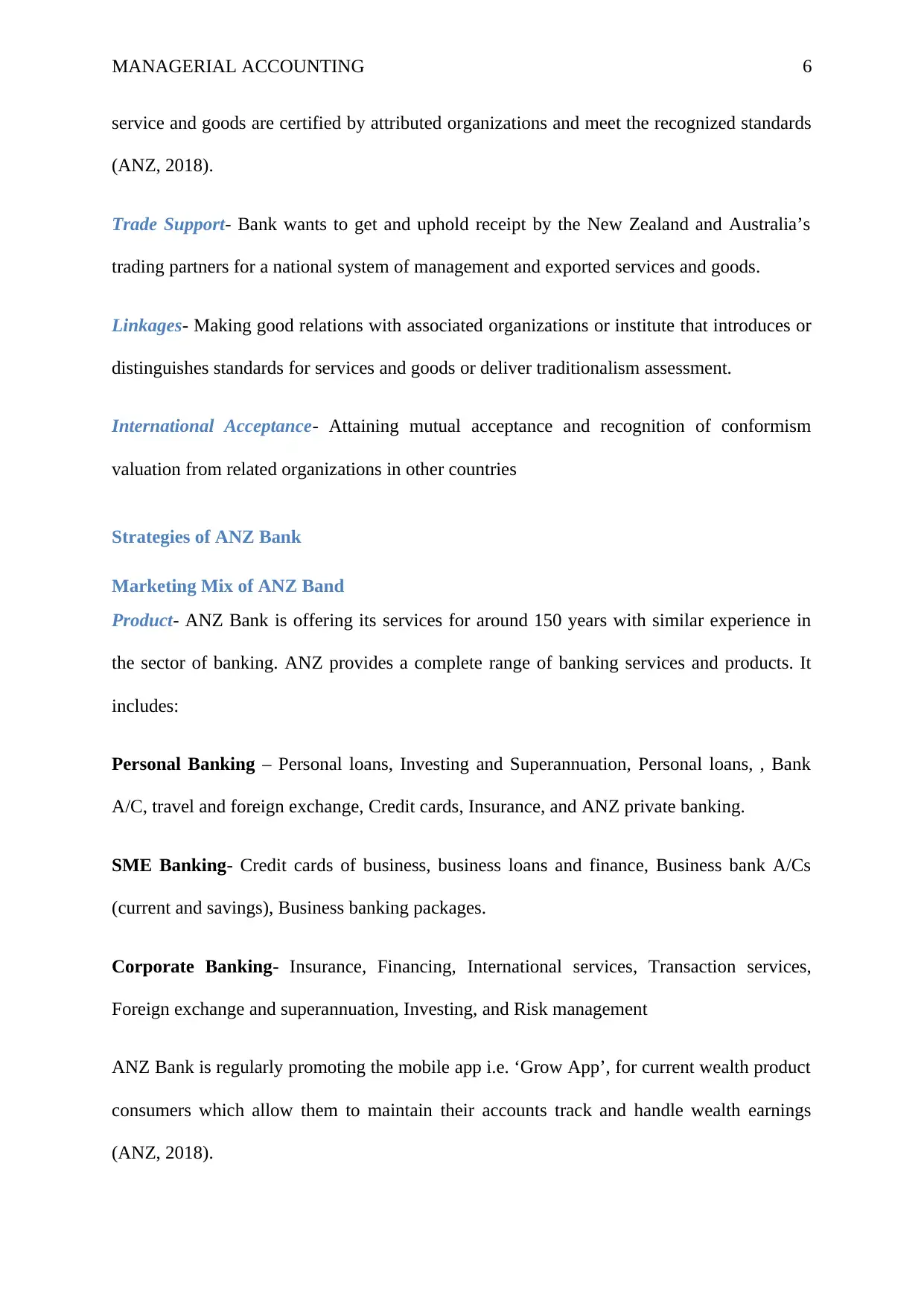
MANAGERIAL ACCOUNTING 6
service and goods are certified by attributed organizations and meet the recognized standards
(ANZ, 2018).
Trade Support- Bank wants to get and uphold receipt by the New Zealand and Australia’s
trading partners for a national system of management and exported services and goods.
Linkages- Making good relations with associated organizations or institute that introduces or
distinguishes standards for services and goods or deliver traditionalism assessment.
International Acceptance- Attaining mutual acceptance and recognition of conformism
valuation from related organizations in other countries
Strategies of ANZ Bank
Marketing Mix of ANZ Band
Product- ANZ Bank is offering its services for around 150 years with similar experience in
the sector of banking. ANZ provides a complete range of banking services and products. It
includes:
Personal Banking – Personal loans, Investing and Superannuation, Personal loans, , Bank
A/C, travel and foreign exchange, Credit cards, Insurance, and ANZ private banking.
SME Banking- Credit cards of business, business loans and finance, Business bank A/Cs
(current and savings), Business banking packages.
Corporate Banking- Insurance, Financing, International services, Transaction services,
Foreign exchange and superannuation, Investing, and Risk management
ANZ Bank is regularly promoting the mobile app i.e. ‘Grow App’, for current wealth product
consumers which allow them to maintain their accounts track and handle wealth earnings
(ANZ, 2018).
service and goods are certified by attributed organizations and meet the recognized standards
(ANZ, 2018).
Trade Support- Bank wants to get and uphold receipt by the New Zealand and Australia’s
trading partners for a national system of management and exported services and goods.
Linkages- Making good relations with associated organizations or institute that introduces or
distinguishes standards for services and goods or deliver traditionalism assessment.
International Acceptance- Attaining mutual acceptance and recognition of conformism
valuation from related organizations in other countries
Strategies of ANZ Bank
Marketing Mix of ANZ Band
Product- ANZ Bank is offering its services for around 150 years with similar experience in
the sector of banking. ANZ provides a complete range of banking services and products. It
includes:
Personal Banking – Personal loans, Investing and Superannuation, Personal loans, , Bank
A/C, travel and foreign exchange, Credit cards, Insurance, and ANZ private banking.
SME Banking- Credit cards of business, business loans and finance, Business bank A/Cs
(current and savings), Business banking packages.
Corporate Banking- Insurance, Financing, International services, Transaction services,
Foreign exchange and superannuation, Investing, and Risk management
ANZ Bank is regularly promoting the mobile app i.e. ‘Grow App’, for current wealth product
consumers which allow them to maintain their accounts track and handle wealth earnings
(ANZ, 2018).
Paraphrase This Document
Need a fresh take? Get an instant paraphrase of this document with our AI Paraphraser
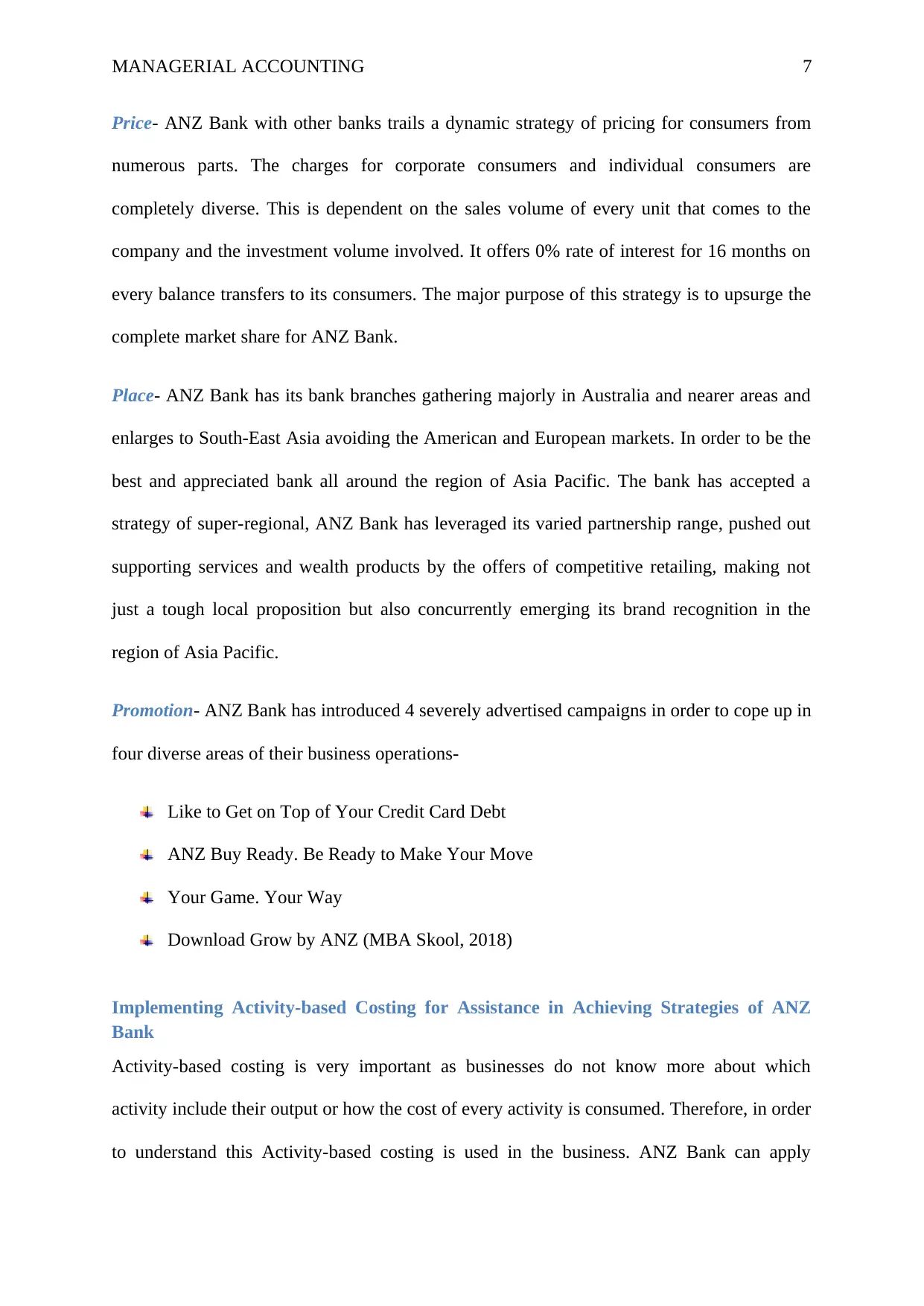
MANAGERIAL ACCOUNTING 7
Price- ANZ Bank with other banks trails a dynamic strategy of pricing for consumers from
numerous parts. The charges for corporate consumers and individual consumers are
completely diverse. This is dependent on the sales volume of every unit that comes to the
company and the investment volume involved. It offers 0% rate of interest for 16 months on
every balance transfers to its consumers. The major purpose of this strategy is to upsurge the
complete market share for ANZ Bank.
Place- ANZ Bank has its bank branches gathering majorly in Australia and nearer areas and
enlarges to South-East Asia avoiding the American and European markets. In order to be the
best and appreciated bank all around the region of Asia Pacific. The bank has accepted a
strategy of super-regional, ANZ Bank has leveraged its varied partnership range, pushed out
supporting services and wealth products by the offers of competitive retailing, making not
just a tough local proposition but also concurrently emerging its brand recognition in the
region of Asia Pacific.
Promotion- ANZ Bank has introduced 4 severely advertised campaigns in order to cope up in
four diverse areas of their business operations-
Like to Get on Top of Your Credit Card Debt
ANZ Buy Ready. Be Ready to Make Your Move
Your Game. Your Way
Download Grow by ANZ (MBA Skool, 2018)
Implementing Activity-based Costing for Assistance in Achieving Strategies of ANZ
Bank
Activity-based costing is very important as businesses do not know more about which
activity include their output or how the cost of every activity is consumed. Therefore, in order
to understand this Activity-based costing is used in the business. ANZ Bank can apply
Price- ANZ Bank with other banks trails a dynamic strategy of pricing for consumers from
numerous parts. The charges for corporate consumers and individual consumers are
completely diverse. This is dependent on the sales volume of every unit that comes to the
company and the investment volume involved. It offers 0% rate of interest for 16 months on
every balance transfers to its consumers. The major purpose of this strategy is to upsurge the
complete market share for ANZ Bank.
Place- ANZ Bank has its bank branches gathering majorly in Australia and nearer areas and
enlarges to South-East Asia avoiding the American and European markets. In order to be the
best and appreciated bank all around the region of Asia Pacific. The bank has accepted a
strategy of super-regional, ANZ Bank has leveraged its varied partnership range, pushed out
supporting services and wealth products by the offers of competitive retailing, making not
just a tough local proposition but also concurrently emerging its brand recognition in the
region of Asia Pacific.
Promotion- ANZ Bank has introduced 4 severely advertised campaigns in order to cope up in
four diverse areas of their business operations-
Like to Get on Top of Your Credit Card Debt
ANZ Buy Ready. Be Ready to Make Your Move
Your Game. Your Way
Download Grow by ANZ (MBA Skool, 2018)
Implementing Activity-based Costing for Assistance in Achieving Strategies of ANZ
Bank
Activity-based costing is very important as businesses do not know more about which
activity include their output or how the cost of every activity is consumed. Therefore, in order
to understand this Activity-based costing is used in the business. ANZ Bank can apply
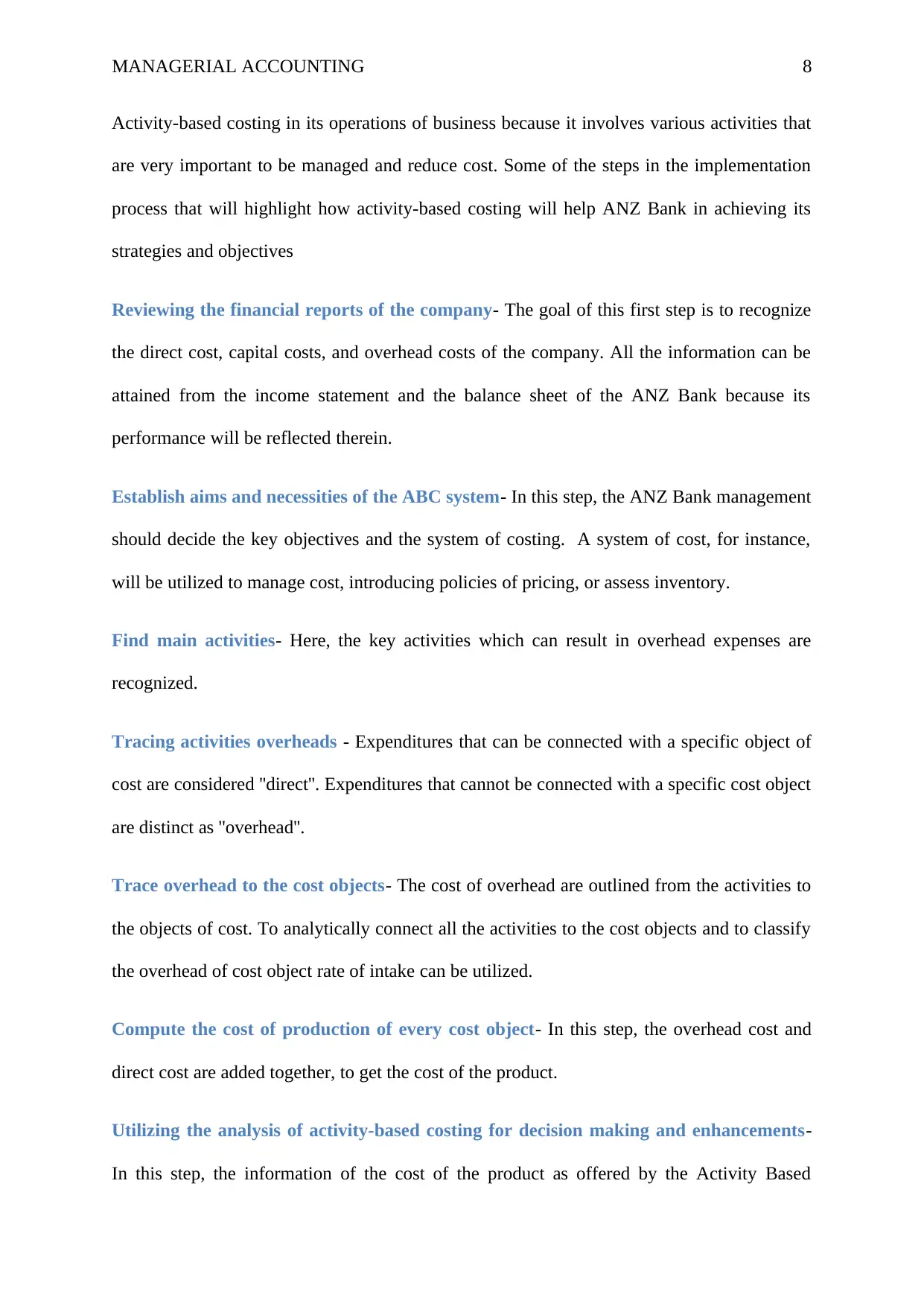
MANAGERIAL ACCOUNTING 8
Activity-based costing in its operations of business because it involves various activities that
are very important to be managed and reduce cost. Some of the steps in the implementation
process that will highlight how activity-based costing will help ANZ Bank in achieving its
strategies and objectives
Reviewing the financial reports of the company- The goal of this first step is to recognize
the direct cost, capital costs, and overhead costs of the company. All the information can be
attained from the income statement and the balance sheet of the ANZ Bank because its
performance will be reflected therein.
Establish aims and necessities of the ABC system- In this step, the ANZ Bank management
should decide the key objectives and the system of costing. A system of cost, for instance,
will be utilized to manage cost, introducing policies of pricing, or assess inventory.
Find main activities- Here, the key activities which can result in overhead expenses are
recognized.
Tracing activities overheads - Expenditures that can be connected with a specific object of
cost are considered ''direct''. Expenditures that cannot be connected with a specific cost object
are distinct as ''overhead''.
Trace overhead to the cost objects- The cost of overhead are outlined from the activities to
the objects of cost. To analytically connect all the activities to the cost objects and to classify
the overhead of cost object rate of intake can be utilized.
Compute the cost of production of every cost object- In this step, the overhead cost and
direct cost are added together, to get the cost of the product.
Utilizing the analysis of activity-based costing for decision making and enhancements-
In this step, the information of the cost of the product as offered by the Activity Based
Activity-based costing in its operations of business because it involves various activities that
are very important to be managed and reduce cost. Some of the steps in the implementation
process that will highlight how activity-based costing will help ANZ Bank in achieving its
strategies and objectives
Reviewing the financial reports of the company- The goal of this first step is to recognize
the direct cost, capital costs, and overhead costs of the company. All the information can be
attained from the income statement and the balance sheet of the ANZ Bank because its
performance will be reflected therein.
Establish aims and necessities of the ABC system- In this step, the ANZ Bank management
should decide the key objectives and the system of costing. A system of cost, for instance,
will be utilized to manage cost, introducing policies of pricing, or assess inventory.
Find main activities- Here, the key activities which can result in overhead expenses are
recognized.
Tracing activities overheads - Expenditures that can be connected with a specific object of
cost are considered ''direct''. Expenditures that cannot be connected with a specific cost object
are distinct as ''overhead''.
Trace overhead to the cost objects- The cost of overhead are outlined from the activities to
the objects of cost. To analytically connect all the activities to the cost objects and to classify
the overhead of cost object rate of intake can be utilized.
Compute the cost of production of every cost object- In this step, the overhead cost and
direct cost are added together, to get the cost of the product.
Utilizing the analysis of activity-based costing for decision making and enhancements-
In this step, the information of the cost of the product as offered by the Activity Based
⊘ This is a preview!⊘
Do you want full access?
Subscribe today to unlock all pages.

Trusted by 1+ million students worldwide
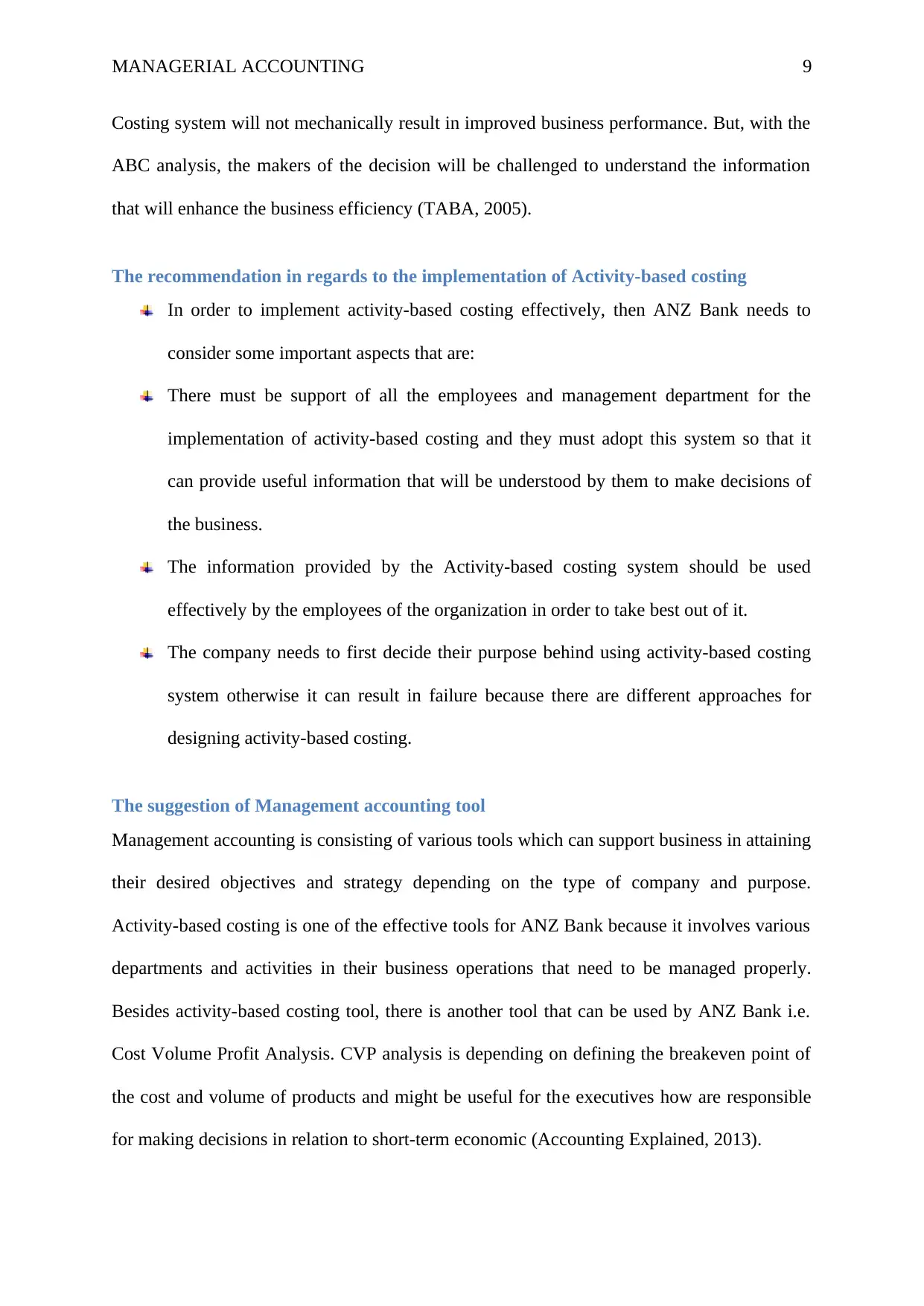
MANAGERIAL ACCOUNTING 9
Costing system will not mechanically result in improved business performance. But, with the
ABC analysis, the makers of the decision will be challenged to understand the information
that will enhance the business efficiency (TABA, 2005).
The recommendation in regards to the implementation of Activity-based costing
In order to implement activity-based costing effectively, then ANZ Bank needs to
consider some important aspects that are:
There must be support of all the employees and management department for the
implementation of activity-based costing and they must adopt this system so that it
can provide useful information that will be understood by them to make decisions of
the business.
The information provided by the Activity-based costing system should be used
effectively by the employees of the organization in order to take best out of it.
The company needs to first decide their purpose behind using activity-based costing
system otherwise it can result in failure because there are different approaches for
designing activity-based costing.
The suggestion of Management accounting tool
Management accounting is consisting of various tools which can support business in attaining
their desired objectives and strategy depending on the type of company and purpose.
Activity-based costing is one of the effective tools for ANZ Bank because it involves various
departments and activities in their business operations that need to be managed properly.
Besides activity-based costing tool, there is another tool that can be used by ANZ Bank i.e.
Cost Volume Profit Analysis. CVP analysis is depending on defining the breakeven point of
the cost and volume of products and might be useful for the executives how are responsible
for making decisions in relation to short-term economic (Accounting Explained, 2013).
Costing system will not mechanically result in improved business performance. But, with the
ABC analysis, the makers of the decision will be challenged to understand the information
that will enhance the business efficiency (TABA, 2005).
The recommendation in regards to the implementation of Activity-based costing
In order to implement activity-based costing effectively, then ANZ Bank needs to
consider some important aspects that are:
There must be support of all the employees and management department for the
implementation of activity-based costing and they must adopt this system so that it
can provide useful information that will be understood by them to make decisions of
the business.
The information provided by the Activity-based costing system should be used
effectively by the employees of the organization in order to take best out of it.
The company needs to first decide their purpose behind using activity-based costing
system otherwise it can result in failure because there are different approaches for
designing activity-based costing.
The suggestion of Management accounting tool
Management accounting is consisting of various tools which can support business in attaining
their desired objectives and strategy depending on the type of company and purpose.
Activity-based costing is one of the effective tools for ANZ Bank because it involves various
departments and activities in their business operations that need to be managed properly.
Besides activity-based costing tool, there is another tool that can be used by ANZ Bank i.e.
Cost Volume Profit Analysis. CVP analysis is depending on defining the breakeven point of
the cost and volume of products and might be useful for the executives how are responsible
for making decisions in relation to short-term economic (Accounting Explained, 2013).
Paraphrase This Document
Need a fresh take? Get an instant paraphrase of this document with our AI Paraphraser
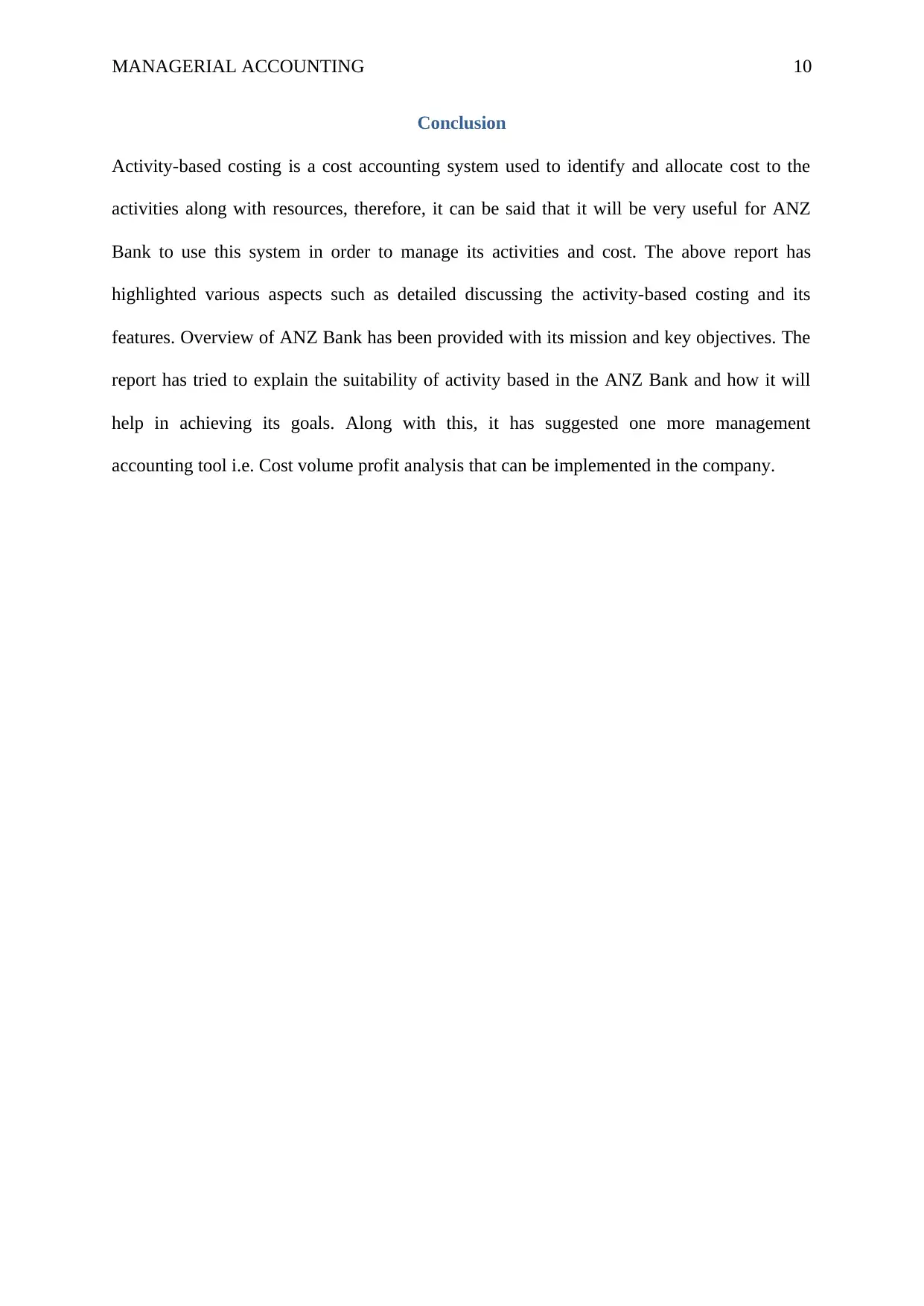
MANAGERIAL ACCOUNTING 10
Conclusion
Activity-based costing is a cost accounting system used to identify and allocate cost to the
activities along with resources, therefore, it can be said that it will be very useful for ANZ
Bank to use this system in order to manage its activities and cost. The above report has
highlighted various aspects such as detailed discussing the activity-based costing and its
features. Overview of ANZ Bank has been provided with its mission and key objectives. The
report has tried to explain the suitability of activity based in the ANZ Bank and how it will
help in achieving its goals. Along with this, it has suggested one more management
accounting tool i.e. Cost volume profit analysis that can be implemented in the company.
Conclusion
Activity-based costing is a cost accounting system used to identify and allocate cost to the
activities along with resources, therefore, it can be said that it will be very useful for ANZ
Bank to use this system in order to manage its activities and cost. The above report has
highlighted various aspects such as detailed discussing the activity-based costing and its
features. Overview of ANZ Bank has been provided with its mission and key objectives. The
report has tried to explain the suitability of activity based in the ANZ Bank and how it will
help in achieving its goals. Along with this, it has suggested one more management
accounting tool i.e. Cost volume profit analysis that can be implemented in the company.
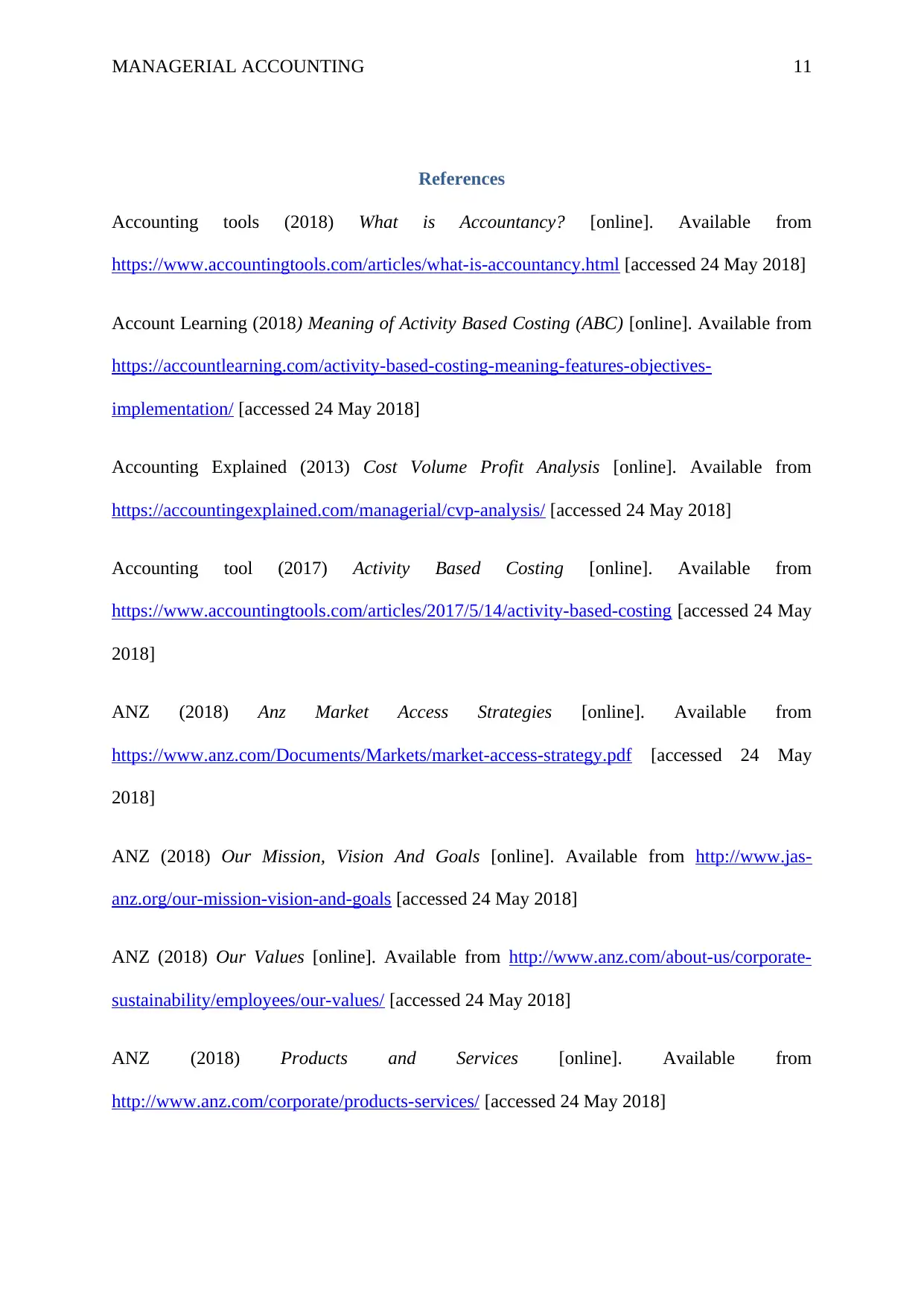
MANAGERIAL ACCOUNTING 11
References
Accounting tools (2018) What is Accountancy? [online]. Available from
https://www.accountingtools.com/articles/what-is-accountancy.html [accessed 24 May 2018]
Account Learning (2018) Meaning of Activity Based Costing (ABC) [online]. Available from
https://accountlearning.com/activity-based-costing-meaning-features-objectives-
implementation/ [accessed 24 May 2018]
Accounting Explained (2013) Cost Volume Profit Analysis [online]. Available from
https://accountingexplained.com/managerial/cvp-analysis/ [accessed 24 May 2018]
Accounting tool (2017) Activity Based Costing [online]. Available from
https://www.accountingtools.com/articles/2017/5/14/activity-based-costing [accessed 24 May
2018]
ANZ (2018) Anz Market Access Strategies [online]. Available from
https://www.anz.com/Documents/Markets/market-access-strategy.pdf [accessed 24 May
2018]
ANZ (2018) Our Mission, Vision And Goals [online]. Available from http://www.jas-
anz.org/our-mission-vision-and-goals [accessed 24 May 2018]
ANZ (2018) Our Values [online]. Available from http://www.anz.com/about-us/corporate-
sustainability/employees/our-values/ [accessed 24 May 2018]
ANZ (2018) Products and Services [online]. Available from
http://www.anz.com/corporate/products-services/ [accessed 24 May 2018]
References
Accounting tools (2018) What is Accountancy? [online]. Available from
https://www.accountingtools.com/articles/what-is-accountancy.html [accessed 24 May 2018]
Account Learning (2018) Meaning of Activity Based Costing (ABC) [online]. Available from
https://accountlearning.com/activity-based-costing-meaning-features-objectives-
implementation/ [accessed 24 May 2018]
Accounting Explained (2013) Cost Volume Profit Analysis [online]. Available from
https://accountingexplained.com/managerial/cvp-analysis/ [accessed 24 May 2018]
Accounting tool (2017) Activity Based Costing [online]. Available from
https://www.accountingtools.com/articles/2017/5/14/activity-based-costing [accessed 24 May
2018]
ANZ (2018) Anz Market Access Strategies [online]. Available from
https://www.anz.com/Documents/Markets/market-access-strategy.pdf [accessed 24 May
2018]
ANZ (2018) Our Mission, Vision And Goals [online]. Available from http://www.jas-
anz.org/our-mission-vision-and-goals [accessed 24 May 2018]
ANZ (2018) Our Values [online]. Available from http://www.anz.com/about-us/corporate-
sustainability/employees/our-values/ [accessed 24 May 2018]
ANZ (2018) Products and Services [online]. Available from
http://www.anz.com/corporate/products-services/ [accessed 24 May 2018]
⊘ This is a preview!⊘
Do you want full access?
Subscribe today to unlock all pages.

Trusted by 1+ million students worldwide
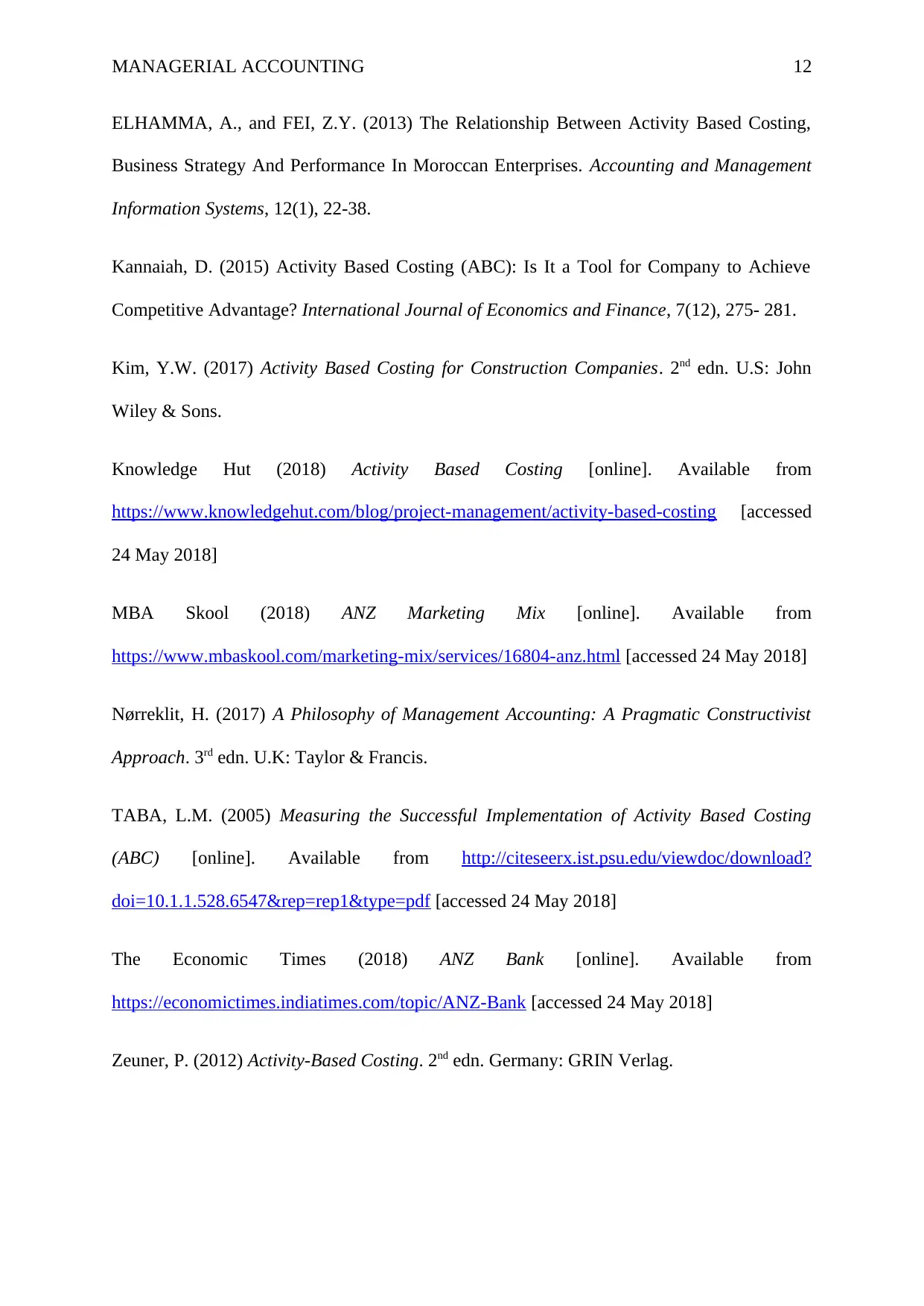
MANAGERIAL ACCOUNTING 12
ELHAMMA, A., and FEI, Z.Y. (2013) The Relationship Between Activity Based Costing,
Business Strategy And Performance In Moroccan Enterprises. Accounting and Management
Information Systems, 12(1), 22-38.
Kannaiah, D. (2015) Activity Based Costing (ABC): Is It a Tool for Company to Achieve
Competitive Advantage? International Journal of Economics and Finance, 7(12), 275- 281.
Kim, Y.W. (2017) Activity Based Costing for Construction Companies. 2nd edn. U.S: John
Wiley & Sons.
Knowledge Hut (2018) Activity Based Costing [online]. Available from
https://www.knowledgehut.com/blog/project-management/activity-based-costing [accessed
24 May 2018]
MBA Skool (2018) ANZ Marketing Mix [online]. Available from
https://www.mbaskool.com/marketing-mix/services/16804-anz.html [accessed 24 May 2018]
Nørreklit, H. (2017) A Philosophy of Management Accounting: A Pragmatic Constructivist
Approach. 3rd edn. U.K: Taylor & Francis.
TABA, L.M. (2005) Measuring the Successful Implementation of Activity Based Costing
(ABC) [online]. Available from http://citeseerx.ist.psu.edu/viewdoc/download?
doi=10.1.1.528.6547&rep=rep1&type=pdf [accessed 24 May 2018]
The Economic Times (2018) ANZ Bank [online]. Available from
https://economictimes.indiatimes.com/topic/ANZ-Bank [accessed 24 May 2018]
Zeuner, P. (2012) Activity-Based Costing. 2nd edn. Germany: GRIN Verlag.
ELHAMMA, A., and FEI, Z.Y. (2013) The Relationship Between Activity Based Costing,
Business Strategy And Performance In Moroccan Enterprises. Accounting and Management
Information Systems, 12(1), 22-38.
Kannaiah, D. (2015) Activity Based Costing (ABC): Is It a Tool for Company to Achieve
Competitive Advantage? International Journal of Economics and Finance, 7(12), 275- 281.
Kim, Y.W. (2017) Activity Based Costing for Construction Companies. 2nd edn. U.S: John
Wiley & Sons.
Knowledge Hut (2018) Activity Based Costing [online]. Available from
https://www.knowledgehut.com/blog/project-management/activity-based-costing [accessed
24 May 2018]
MBA Skool (2018) ANZ Marketing Mix [online]. Available from
https://www.mbaskool.com/marketing-mix/services/16804-anz.html [accessed 24 May 2018]
Nørreklit, H. (2017) A Philosophy of Management Accounting: A Pragmatic Constructivist
Approach. 3rd edn. U.K: Taylor & Francis.
TABA, L.M. (2005) Measuring the Successful Implementation of Activity Based Costing
(ABC) [online]. Available from http://citeseerx.ist.psu.edu/viewdoc/download?
doi=10.1.1.528.6547&rep=rep1&type=pdf [accessed 24 May 2018]
The Economic Times (2018) ANZ Bank [online]. Available from
https://economictimes.indiatimes.com/topic/ANZ-Bank [accessed 24 May 2018]
Zeuner, P. (2012) Activity-Based Costing. 2nd edn. Germany: GRIN Verlag.
Paraphrase This Document
Need a fresh take? Get an instant paraphrase of this document with our AI Paraphraser

MANAGERIAL ACCOUNTING 13
1 out of 14
Related Documents
Your All-in-One AI-Powered Toolkit for Academic Success.
+13062052269
info@desklib.com
Available 24*7 on WhatsApp / Email
![[object Object]](/_next/static/media/star-bottom.7253800d.svg)
Unlock your academic potential
© 2024 | Zucol Services PVT LTD | All rights reserved.




